
Jarideh S., Alvaninezhad S., Gholami P., Mirzaei M.R., Armin M. SOIL PROPERTIES AND SOIL ORGANIC CARBON STOCK CHANGES RESULTED FROM DEFORESTATION IN A SEMI-ARID REGION OF ZAGROS FORESTS, IRAN // Arid ecosystems. 2021. V. 27. № 1 (86). P. 24-34. | PDF
Today, population growth and demand for agricultural production have resulted in the significant damage to the natural ecosystem, including forests and rangelands, and have turned them into farmlands. Territorial land use changes can result in changes in chemical and physical features of soils, which in turn, may ultimately lead to land degradation. Understanding the effects of land use changes on soil features is very important as it helps with assessing the sustainability of natural ecosystems. Therefore, in the current study, we sought to compare changes in soil physico-chemical properties, soil deterioration index (SDI), soil erodibility factor (K factor) and the soil organic carbon (SOC) stock in three types of land use, namely: protected forest (PF), natural forest (NF) with common exploitation (overgrazing and fuel wood) and cultivated land (CL) in semi-arid regions in western Iran. Soil samples were randomly collected from 0-30 cm depths (16+18+18 at each land use, respectively; 52 samples in total). The soil texture, pH, exchangeable K, available P, total N, soil organic carbon and SOC stock were measured in soil samples. The findings indicated that in general, overgrazing with the exploitation of trees in the NF and changing the NF to CL caused a significant increase in sand (by 22.3-90.5%) and bulk density (6.1-9.16%) and a significant decrease in silt (4.34-13.56%), clay (2.36-13.5%) exchangeable K (37.68-50.63%), available P (15.58-27.42%), total N (22.2-55.5%), soil organic carbon (22.3-52.4%) and SOC stock (22.87-52.3%) (P <0.01). The outcomes of multivariate analysis (RDA) indicated that CL correlated with sand, pH and bulk density, and EF correlated with most soil properties. The outcomes of SDI were indicative of a significant reduction in quality of soil (-5.5%) under CL, compared with NF (-21.5%) and EF (0.1%). The highest value of soil erodibility factor (K factor) was observed in the CL (0.260), and the lowest was at the PF (0.214). In general, the findings of this study showed that the exploitation of trees for fuel wood with overgrazing in the NF and after transformation of the NF to the CL caused a significant deterioration in the soil properties in the semi-arid region in western Iran.
Keywords: natural forest, soil erodibility factor, soil organic carbon, soil deterioration index, Zagros forests.
DOI: 10.24411/1993-3916-2021-10134











